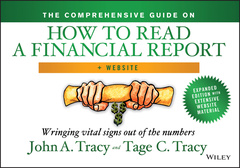Description
The Comprehensive Guide on How to Read a Financial Report, + Website
Wringing Vital Signs Out of the Numbers
Authors: Tracy John A., Tracy Tage C.
Language: English
Subject for The Comprehensive Guide on How to Read a Financial...:
Keywords
how to read a financial report; financial reports; how to understand financial reports; reading financial reports; financial reporting standards; john a; tracy; financial reports; company financial reports; types of financial reports; understanding financial reports; comprehensive annual financial report; annual financial report; financial reports for companies; reading financial statements; how to read financial statements; how to read financial reports
352 p. · 25.4x17.3 cm · Hardback
Description
/li>Contents
/li>Biography
/li>
Financial reports provide vital information to investors, lenders, and managers. Yet, the financial statements in a financial report seem to be written in a foreign language that only accountants can understand. This comprehensive version of How to Read a Financial Report breaks through that language barrier, clears away the fog, and offers a plain-English user's guide to financial reports. The book features new information on the move toward separate financial and accounting reporting standards for private companies, the emergence of websites offering financial information, pending changes in the auditor's report language and what this means to investors, and requirements for XBRL tagging in reporting to the SEC, among other topics.
- Makes it easy to understand what financial reports really say
- Updated to include the latest information financial reporting standards and regulatory changes
- Written by an author team with a combined 50-plus years of experience in financial accounting
- This comprehensive edition includes an ancillary website containing valuable additional resources
With this comprehensive version of How to Read a Financial Report, investors will find everything they need to fully understand the profit, cash flow, and financial condition of any business.
List of Exhibits ix
Preface xv
Part One—Financial Report Fundamentals
1 Financial Statement Basics: The Real Meat and Potatoes of Financial Reports 3
2 Starting with Cash Flows 13
3 Mastering the Balance Sheet 21
4 Understanding Profit 31
5 Profit isn’t Everything and All Things 43
Part Two—Working Capital Connections
6 Our Case Study—Company Introductions 55
7 Sales Revenue, Trade Accounts Receivable, and Deferred Revenue 65
8 Cost(s) of Goods Sold Expense and Inventory 77
9 Inventory and Accounts Payable 89
10 Operating Expenses and Accounts Payable 99
11 Accruing Liabilities for Incurred but Unpaid Expenses 109
12 Income Tax Expense—A Liability and Asset? 117
Part Three—Financial Capital Connections and Cash Flows
13 Our Case Study—Company Updates and Assessments 129
14 Long-Term Assets and Depreciation, Amortization, and Other Expenses 139
15 Long-Term Liabilities, Interest, and Other Expenses 151
16 Net Income, Retained Earnings, Equity, and Earnings per Share (EPS) 163
17 Cash Flow from Operating (Profit-Making) Activities 173
18 Cash Flows from Investing and Financing Activities 183
Part Four—Financial Report Analysis
19 Expansion and Contraction Impacts on Cash Flow 195
20 What is EBITDA and Why is it Important? 211
21 Financial Statement Footnotes—The Devil’s in the Details 217
22 Financial Statement Ratios—Calculating and Understanding 229
23 Profit Analysis for Business Managers 245
24 Our Case Study and the Moral of the Story—The Good, the Bad, and the Ugly 259
Part Five—Financial Report Truthfulness
25 Choosing Accounting Methods and Massaging the Numbers 273
26 Audits of Financial Reports 285
27 Small Business Financial Reporting 299
28 Basic Questions, Basic Answers, No BS 309
About the Authors 319
About the Companion Website 321
Index 323
JOHN A. TRACY is a successful financial accounting author. In addition to all eight editions of this book, he is the author of a number of books including the best-selling Accounting For Dummies.
TAGE C. TRACY heads a consulting firm specializing in providing executive-level financial and accounting management resources on a project and/or interim basis. He has worked with companies in an array of industries ranging from web-based technology/solutions to manufacturing to retail to professional service organizations and finance. In addition, Tage has co-authored Cash Flow For Dummies and Small Business Financial Management Kit For Dummies with his father.




